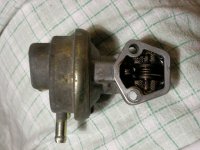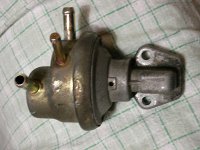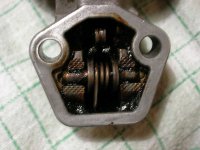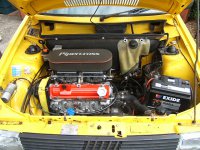1990 Uno 1.0 engine, manual fuel pump.
Car cut-out in the middle of crossing a major road... coasted to the shoulder just in time to avoid a collision, whew!
Checked for spark - got. Checked for fuel in the in line filter - none. Tryed to get a pump here locally (Ireland) not a hope, even from the Fiat dealer.
By chance a person walked up to me and asked what was wrong, I guess he saw my Italian plates and thought I was a fellow country-man, I told him the problem and told me that of the dozens of Uno he had worked on (he was a retired Fiat mechanic, what were the chances of that!) with this problem it turned out to never be the fuel pump, but the push rod that operates off the cam that actually pumps the fuel pump.
The cam, I guess is wore past spec for the pump push rod.
So, what to do: he said
1.) Remove one of the the gasket shims on the pump, thus bringing the pump closer to the push rod thereby increasing the fuel pressure.
But I didn't have any shims just one 3mm hard gasket.
2.) Refit the manual pump and block off the fuel ports.
Buy an electric pump and route the fuel line through it.
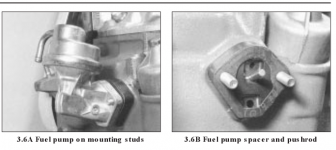
My questions.
1.) Has anyone installed an electric pump in place of a manual one, if so what make/ model /PSI of pump, Haynes says 0.176bar/ 2.55 PSI to the carb but this sounds very low.
2.) If I can get some soft gasket material is it feasible to make a handmade gasket of 3 mm and then compress the soft 3mm to 2.5 mm
when I put the 2 pump retaining bolts back on? This would move the push rod closer to the pump.
I don't think I can cut a hard gasket to the shape of pump face.
Any help would be appreciated... Lance
Car cut-out in the middle of crossing a major road... coasted to the shoulder just in time to avoid a collision, whew!
Checked for spark - got. Checked for fuel in the in line filter - none. Tryed to get a pump here locally (Ireland) not a hope, even from the Fiat dealer.
By chance a person walked up to me and asked what was wrong, I guess he saw my Italian plates and thought I was a fellow country-man, I told him the problem and told me that of the dozens of Uno he had worked on (he was a retired Fiat mechanic, what were the chances of that!) with this problem it turned out to never be the fuel pump, but the push rod that operates off the cam that actually pumps the fuel pump.
The cam, I guess is wore past spec for the pump push rod.
So, what to do: he said
1.) Remove one of the the gasket shims on the pump, thus bringing the pump closer to the push rod thereby increasing the fuel pressure.
But I didn't have any shims just one 3mm hard gasket.
2.) Refit the manual pump and block off the fuel ports.
Buy an electric pump and route the fuel line through it.

My questions.
1.) Has anyone installed an electric pump in place of a manual one, if so what make/ model /PSI of pump, Haynes says 0.176bar/ 2.55 PSI to the carb but this sounds very low.
2.) If I can get some soft gasket material is it feasible to make a handmade gasket of 3 mm and then compress the soft 3mm to 2.5 mm
when I put the 2 pump retaining bolts back on? This would move the push rod closer to the pump.
I don't think I can cut a hard gasket to the shape of pump face.
Any help would be appreciated... Lance


